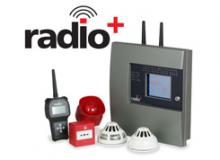Competent?
Competent?
Just occasionally something stands out as being wrong, maybe an element of the systems design, an installation issue, poor maintenance or a system that has not been modified to reflect changes to building layout. There have been smoke detectors left covered with masking tape after redecoration, call points behind vending machines, or with the glass element broken, but supplemented by a matchstick or even with the broken glass reversed, so if used again the user would be exposed to the broken edge of the glass and the extra force required to overcome the plastic coating which is now on the back.
Wireless fire alarm systems are not new, but the publishing of EN54-25 ‘Fire detection and fire alarm systems. Components using radio links‘ has provided the basis for a number of new entrants to the market which has allowed a multiplicity of fire companies to have access to wireless system equipment.
Recently on a short break in Mid-Wales, I stayed at a country hotel where the common areas of the building were protected by a conventional system some 25 years old with a mixture of elderly, but good quality detectors and original ‘smash-glass’ type call points (with hammers). The concern arose when a recent system extension was noticed. The bedrooms had been upgraded with wireless smoke detectors, and a small wireless control panel interfaced into the old conventional panel, situated in the corridor to the restaurant. I guess at one time this would have been the hotels reception, before various additions, but not now ideally placed for anyone to access.
The execution of the wireless extension was perfunctory, to say the least, with the control unit squeezed into a space that was convenient to the installer, but probably nobody else, as the controls and display were accessible only with a good stoop.
The antenna for the wireless control panel was pressed against the steel case of the old original panel which would have a major influence on the radiation pattern and efficiency of the antenna. The wireless panel was then linked into the main panel using what appeared to be non-protected cables; one for power and one for data; in fact the data cable had an exposed ‘D’ connector entering the bottom of the panel which could have been removed by anybody passing by. Yes I was tempted, but too sensible!
One member of the staff, who was well versed with many aspects of fire safety and electrical installation, said the system had been inspected recently and all fire certificates were up to date, but there were still frequent false alarms from two of the bedrooms and the installation company was paying regular visits to try to cure the problems by changing bits of the system.
There is no doubt that in a working hotel the radio linked detection interfaced to the existing system was a good solution, allowing a comparatively quick installation with the minimum of disruption to the hotels functioning. However although detection had been added to the bedrooms the sounder provision was still reliant on sounders in the maze of corridors outside, so it was unlikely that the minimum sound levels would ever be achieved within the rooms. A surprising omission given that wireless sounders can be fitted as easily as detectors and in some systems the two are combined to allow a single point fixing.
The impression was that that the installing / commissioning company had either received inadequate training regarding the wireless additions or chosen to ignore it. Perhaps a more cynical view was that the lack of cabling allowed the installation to be performed by less skilled personnel and hence the unprotected interconnections at the control panel. It should also be added that the radio components, which were of German origin and no doubt well engineered, appeared ill-suited to UK installation practice and cabling requirements according to BS 5839-1.
In my opinion this job had not been executed well, but the authorities seemed satisfied enough to accept it and the customer also appeared to be relatively happy, so perhaps I am just being picky. This was however a life safety system protecting somewhere around 40 guests in an old building with complicated escape routes and inadequate sounder provision.
Despite the compliance with the normal installation codes used in the UK, it must be of benefit to all parties to have a trouble free system, particularly in a hotel where the effect of a disturbed night for guests cannot be underestimated. That the initial problems were not being rectified despite repeated visits will erode confidence in both the supplier / installer and the ultimately the equipment, which was probably not at fault.
Wired systems are generally well understood by many installers, but the commercial opportunities presented by wireless systems may tempt some to operate beyond their competence. While radio systems do bring significant installation advantages in some situations, they do require careful planning and extra time on site to ensure that the wireless communications will operate consistently and any supplier should be able to demonstrate their competence with the particular equipment being offered.
Although a wireless system has been used as an example here, competence issues are increasing as the economic climate has driven installers to take on projects they may be ill equipped to handle. The enquiries received by Cooper Fulleon over the past two years have exhibited an increase in the number of inexperienced and untrained personnel attempting work that they simply do not understand and the consequence of such installations can only be wondered at.
While there are schemes such as BAFE SP203 to attest competence and there are a range of training courses from the Fire Industries Association, legislation is lacking to compel individuals or companies undertake a formal qualification or registration to be allowed to work on fire alarm systems. This must be addressed.
For further information visit: www.cooperfulleon.com

